For data-driven businesses, creating an environment where customer data can flow and be executed without any quality loss is essential. For that, companies use ETL tools that allow them to unify their data and gather it in one centralized place.
Find the best ETL tools for your business in our blog post.
Table of contents
What are ETL tools?
ETL is a workflow in the modern data analysis stack that extracts data from third-party software or databases, transforms it, and then loads it into a data warehouse or data lake.
ETL tools automate this process in minutes without the time-consuming and costly development of your own data pipelines.
How do ETL tools work?
The abbreviation ETL describes the three steps mentioned above. Here’s how each of them is executed.
Extract. The first step implies extracting data from sources, for instance, ad platforms, sales CRMs, databases, and others. For this step, teams must either write custom code or use open-source and SaaS products.
Transform. The transformation implies normalizing and modeling the data — renaming columns, correcting the casting of the fields, etc. The goal is to bring the data to a format that will allow using it by different teams and for different tasks.
Load. Finally, the data is loaded into centralized storage, such as a data warehouse. You can use this data in different BI tools, reporting systems, machine learning, or other platforms for further use and analysis.
How to choose an ETL tool for your data stack
There are several factors to pay attention to when picking an ETL tool.
Data sources and destinations. Find the tools that are compatible with the tools you use. If you’re using Facebook Ads — make sure that the chosen ETL solution works with that platform. Same for destinations, aka data warehouses — they must be supported by your ETL tool.
Pricing. ETL tools vary in price from being completely free to use to charging $2500+. Find a solution that fits your budget while covering all your ETL needs.
Open-source. Open source solutions allow adjusting the workflow and building custom pipelines. This, however, often requires strong technical skills. Besides, open-source solutions are usually free of charge.
Types of ETL tools
There are four types of ETL tools based on their infrastructure and developing company.
Enterprise software ETL tools. Enterprise ETL tools are typically built on a serverless cloud and provide graphical interfaces for creating and maintaining ETL pipelines. These products support the most popular business applications. Some vendors support streaming data sources.
Typically, these tools require minimal developer support and little investment in cloud architecture. They also provide SLAs.
Cloud-based ETL tools. Cloud service providers, such as Amazon AWS, Google Cloud, and Microsoft Azure, have created their own ETL tools that are easily integrated within their CSP’s environment.
Besides, there are SaaS providers of ETL that focus solely on this field — these can be integrated within different environments and are capable of creating pipelines that connect multiple tools within one workflow. Many cloud-based ETL tools are easy to use and do not require a deep knowledge of programming languages.
Cloud-based ETL tools do not support on-premise data centers unless they are backed up in a cloud.
Open-source ETL tools. There are several ETl tools on the market created by enthusiast developers that are free for anyone to use. Because their source code is freely available, anyone can modify the tools.
Many open-source ETL products offer a graphical user interface for creating and executing pipelines. However, because open-source products are not curated by commercial organizations, they vary greatly in terms of ease of use, quality, adoption, and support availability. Generally, open-source tools require an experienced developer.
Custom ETL tools. ETL pipelines can be built from scratch to meet the specific needs of a business. For this, teams use programming languages like SQL, Python, and Java.
This approach requires a dedicated developing team to create the workflow, maintain it, build documentation and test the performance. On the other hand, custom-built pipelines allow for the most flexibility.
List of the best ETL tools
There are many options on the market for different types of businesses. We handpicked the best ones. Enjoy!
1. Renta Marketing ETL
ETL tool by Renta is a cloud-based solution that allows integrating over 28 enterprise data sources with the most popular data warehouses, such as Snowflake and BigQuery.

The main advantage of Renta’s tool is its ease of use — it allows a team of engineers and analysts to integrate their third-party tools and create code-free data pipelines in minutes. It requires little to no developer support. One integration — for instance, Facebook Ads to BigQuery — can be created just in 4 clicks.
You can stream your customer behavioral data from multiple sources to your data warehouse using Renta tools. The solution does not require thorough maintenance — you build the pipeline once and then enjoy the results for upcoming months and years. What's equally important and valuable is that Renta ensures strong data security.
Type: cloud.
Ease of use: 5/5.
Pricing: from $30 per month, based on incoming rows of data.
Free trial: 7 days. No credit card required
2. Stitch
Another great solution for those who want to skip the coding and go straight to the analytics part is Stitch. This tool enables marketers and product managers to replicate unstructured data from multiple sources and supports 10 data warehouses, including Snowflake and Google BigQuery.
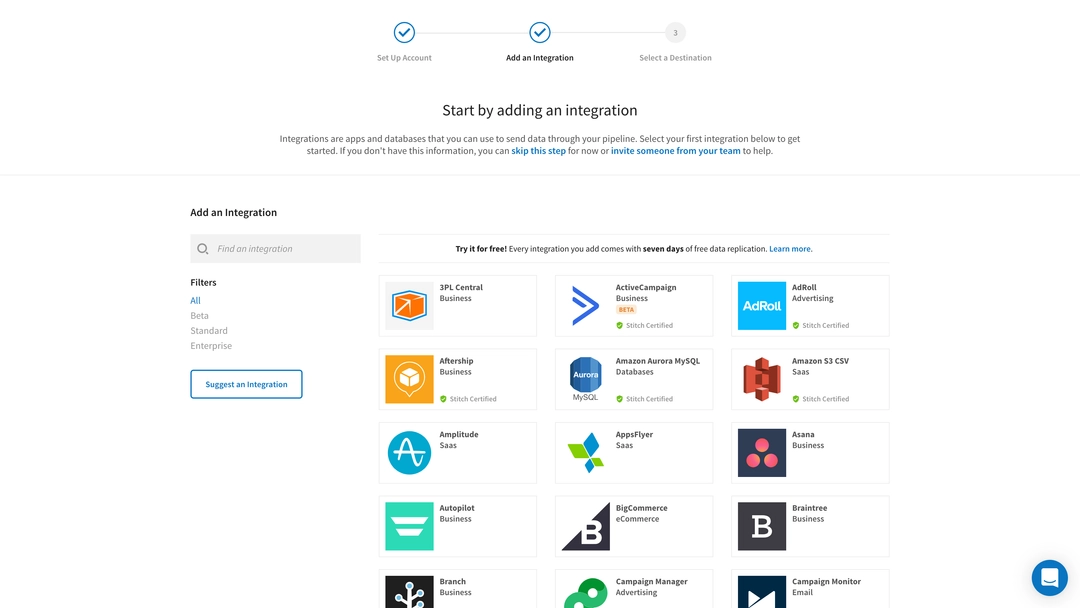
At the premium plans, Stitch allows for much more flexibility. These options are aimed at experienced developers and allow connecting to all the mentioned data sources.
The standard plan implies integrating only up to 10 sources out of 130 available options.
Type: cloud
Ease of use: 5/5
Pricing: from $100 per month, depending on incoming rows of data
Free trial: 14 days, no credit card required
3. Fivetran
Fivetran is a cloud-based ETL software that allows users to build pipelines quickly and easily. Aside from the most popular data warehouses, the platform supports over 90 sources.
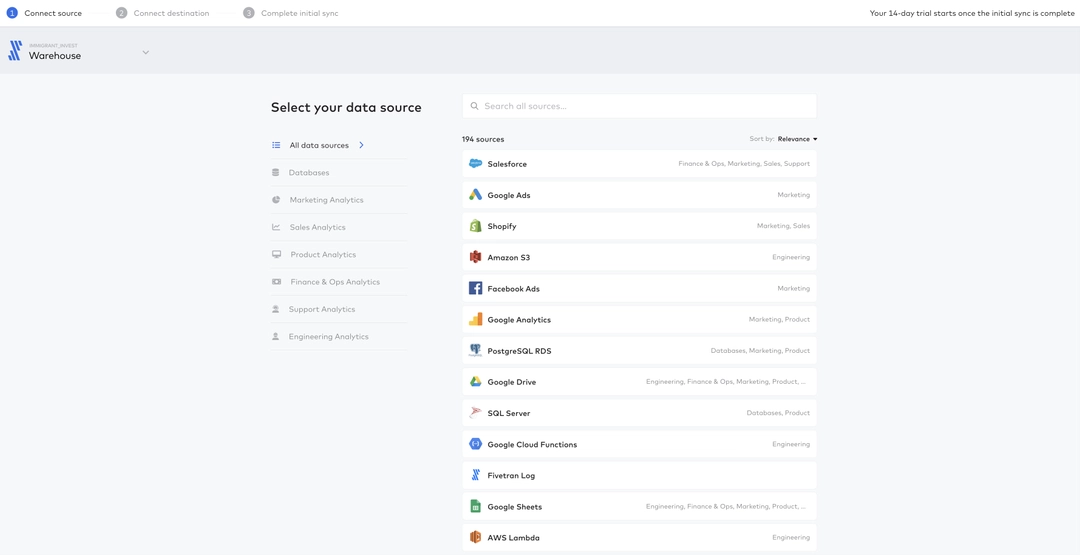
This tool provides users with a diverse set of pre-built integrations, making the work more accessible even for coding novices. Integrate data as if it were a game!
Type: cloud
Ease of use: 5/5
Pricing: from $24 per month depending on incoming rows of data
Free trial: 14 days, no credit card required
4. Hevo Data
The Hevo Data pipeline provides users with over 150 pre-built integrations. Like the tools mentioned above, it is very user-friendly and requires little to no coding.
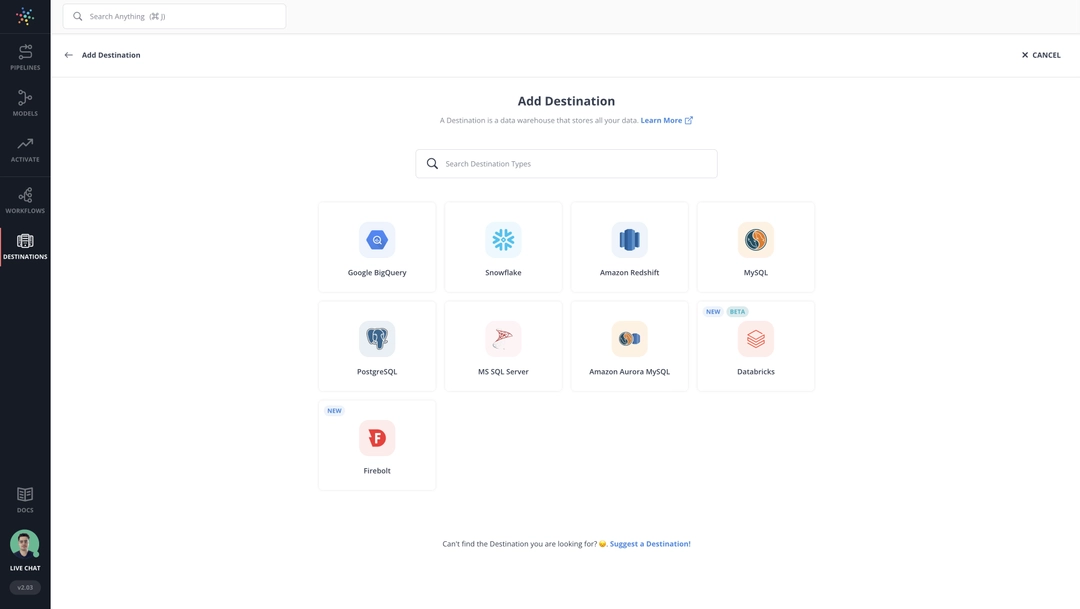
You can do this with most integrations in three easy steps. After that, you get a pipeline that replicates data to the warehouse and does not require maintenance. Data management made easy!
The great thing about Hevo is the free plan that is active for the first 1 mln events and includes over 50 data sources. Then the pricing depends on the volume of data.
Type: cloud
Ease of use: 5/5
Pricing: from $0 per month for the first 1 mln events, after that — from $239 per month depending on incoming rows of data
Free trial: 14 days, no credit card required
5. Skyvia
Skyvia cloud-based ETL platform offers tools for both simple and complex use cases. Neither of them requires deep knowledge of coding.
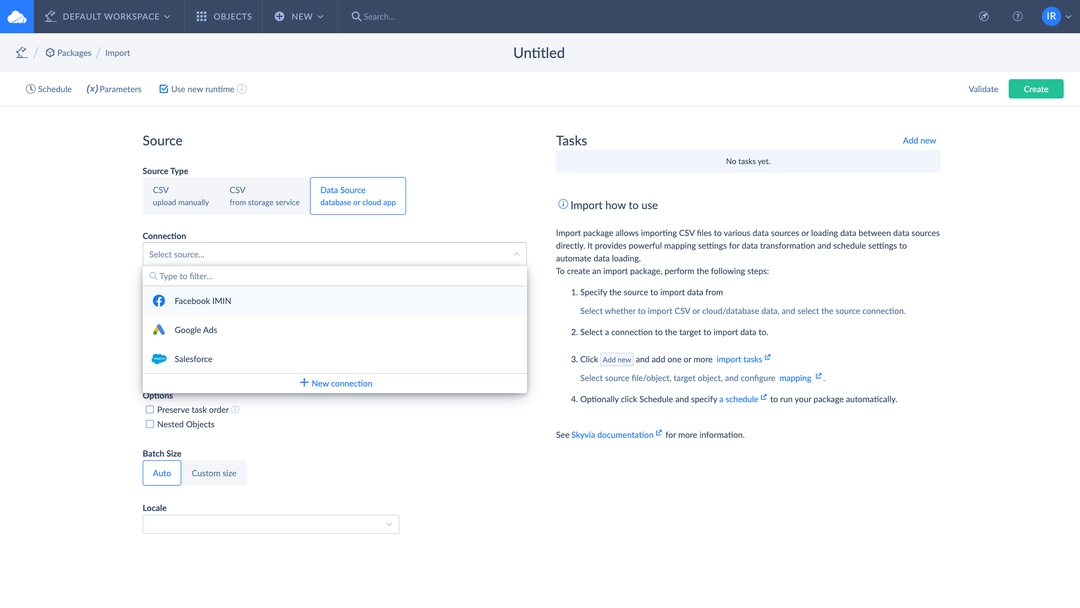
Skyvia provides an intuitive and user-friendly interface that allows users to quickly and easily build pipelines between different sources and destinations. Aside from that, the tool features a powerful query editor which allows users to easily create and modify SQL queries and manipulate data as needed.
Additionally, Skyvia offers users real-time data synchronization, allowing users to keep their data up to date without needing manual updates.
Type: cloud
Ease of use: 3/5
Pricing: from $0 for up to 5k records per month
Free trial: 14 days
6. Matillion
Another great low-code solution for creating data pipelines is Matillion. It enables businesses to build pipelines and automate data processing rapidly. It features an easy-to-use interface to create, monitor, and manage data transformations.
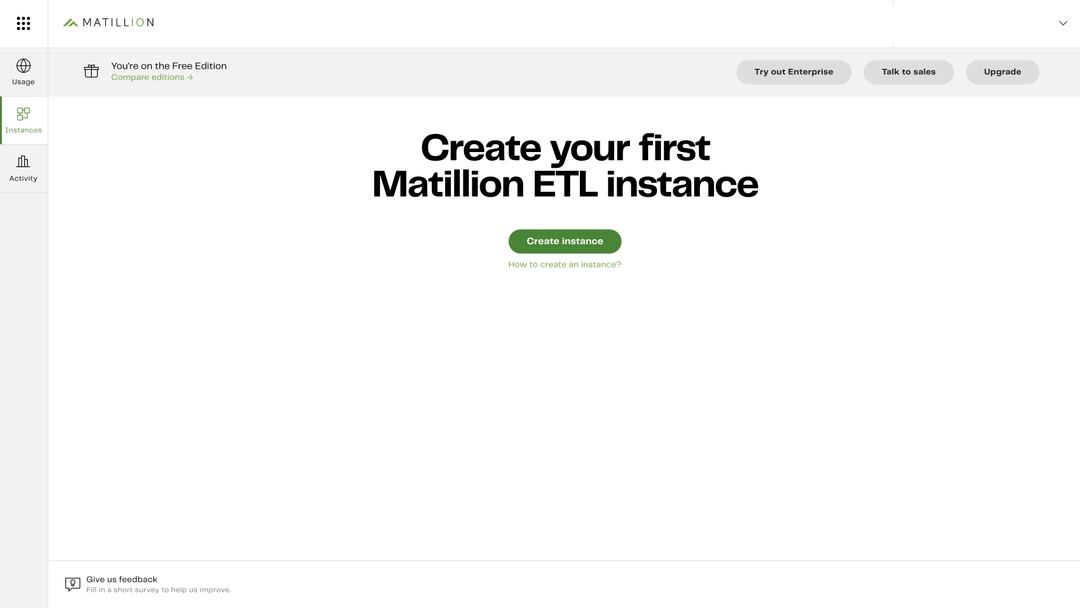
Matillion supports both batch and real-time processing. It comes with a number of pre-built connectors supporting the most popular data sources and destinations. Additionally, Matillion ETL provides comprehensive monitoring capabilities, allowing users to easily identify and rectify any issues within their data transformations.
Type: cloud
Ease of use: 3/5
Pricing: from $0 for up to 1 mln rows per month
Free trial: 14 days
7. Dataddo
Dataddo provides a suite of cloud-based tools to help businesses integrate, store, and analyze data from multiple sources.
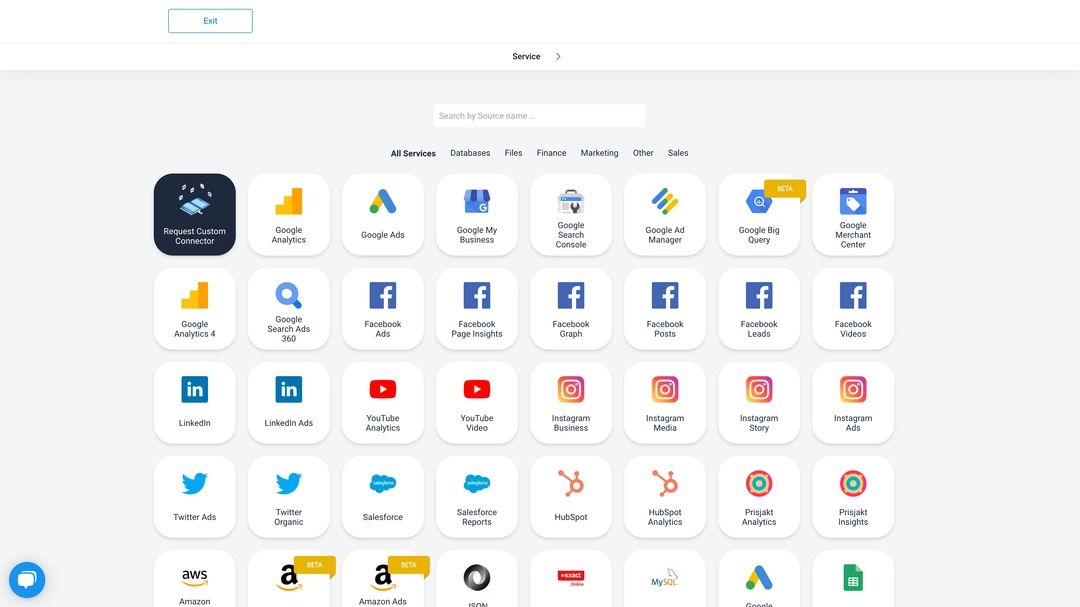
With Dataddo, users can quickly and easily ingest, transform, and combine data from various sources, including databases, web APIs, and flat files into a single, unified environment.
Dataddo also features automated workflows, data quality monitoring, and error handling to ensure data accuracy. With its extensive collection of features, Dataddo makes it easy for businesses to build data pipelines quickly and efficiently.
Type: cloud
Ease of use: 4/5
Pricing: from $3 for up to 3 mln flows per month
Free trial: 14 days, no credit card required
8. Google Cloud DataFlow
Dataflow is an ETL tool developed by Google Cloud that helps data engineers quickly and easily transform their data stream into a format that can be consumed by Google applications. It is a serverless cloud computing service that processes batch and streaming data.
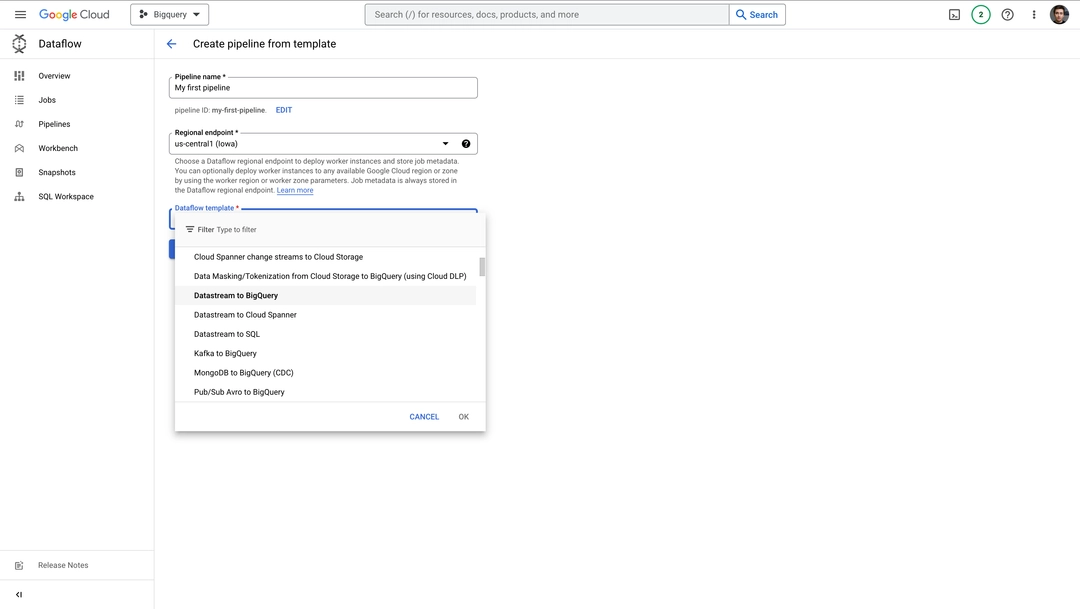
It also provides users with a wide range of features, such as automatic scaling, fault tolerance, data access control, and more. With Dataflow, businesses can quickly and efficiently move data from source to destination and transform it in order to gain insights from their data.
Type: cloud
Ease of use: 4/5
Pricing: flexible pricing plans based on used resources
Free trial: 90 days, no credit card required
9. Integrate.io
Integrate.io is another cloud data integration platform that allows designing pipelines with almost no coding. It enables users to integrate dozens of data sources with nearly any data warehouse.
Integrate.io is a user-friendly tool that allows people with minimal knowledge of programming languages to integrate their business solutions. On the other hand, for those who do want to execute their coding skills, Integrate.io offers many opportunities for customization thanks to rich expression language, advanced API, and webhooks.
Type: cloud
Ease of use: 5/5
Pricing: a flat fee depending on the number of connectors
Free trial: 14 days, no credit card required.
10. Supermetrics
Supermetrics is an ETL solution aimed specifically at small businesses and marketers whose analytics game is limited mainly by Facebook Ads, Google Ads, and Google Analytics.
This tool boasts a native application in the Google Cloud Platform that allows you to export data directly to Google BigQuery. Its pricing model is based on the chosen type of destination and the number of data sources.
For instance, exporting data to Google BigQuery from up to 11 sources will cost you $99 per month. Replicating data into BigQuery or Snowflake will cost more.
Type: cloud
Ease of use: 4/5
Pricing: from $99 per month, depending on the destination and the number of sources
Free trial: 14 days
11. Talend Open Studio
Talend Open Studio is an open-source ETL solution that provides a graphical user interface and allows users to create and manage data pipelines for a variety of data sources. The tool is built on the Eclipse platform and has a library of components for connecting to various data sources, such as databases, flat files, and web services. It also includes features such as data profiling, cleansing, and transformation.
Type: open-source
Ease of use: 4/5
Pricing: free to use
12. Informatica PowerCenter
Informatica PowerCenter is an enterprise ETL tool used to quickly and efficiently extract data from multiple sources, transform it and then load data into the target database.
Informatica PowerCenter is a popular ETL tool used by many companies, especially those in the financial and healthcare industries. It provides an intuitive user interface, powerful transformation capabilities, and the ability to easily scale up to handle large amounts of data. It also offers built-in support for a range of data sources, including Oracle, SQL Server, and Teradata. Informatica PowerCenter is a reliable solution for organizations that need to move large amounts of data quickly and securely.
Type: enterprise
Ease of use: 3/5
Pricing: starts at $2000 per month
Free trial: 30 days
13. Azure Data Factory
Azure Data Factory is a fully managed data integration solution allowing you to move and transform data from various sources quickly. With Azure Data Factory, you can develop, schedule, and monitor data pipelines to move and transform data from various sources into Azure data stores.
You can also use Azure to move data from on-premises sources to the cloud and vice versa. It offers a graphical interface and a library of data transformation activities for quickly creating powerful data pipelines. Additionally, it provides built-in monitoring and alerting capabilities to ensure your data pipelines are running as expected.
Type: cloud
Ease of use: 3/5
Pricing: flexible pay-as-you-go model
Free trial: 30 days
14. Striim
Striim enables real-time streaming data integration and provides a comprehensive, end-to-end solution for data transformation.
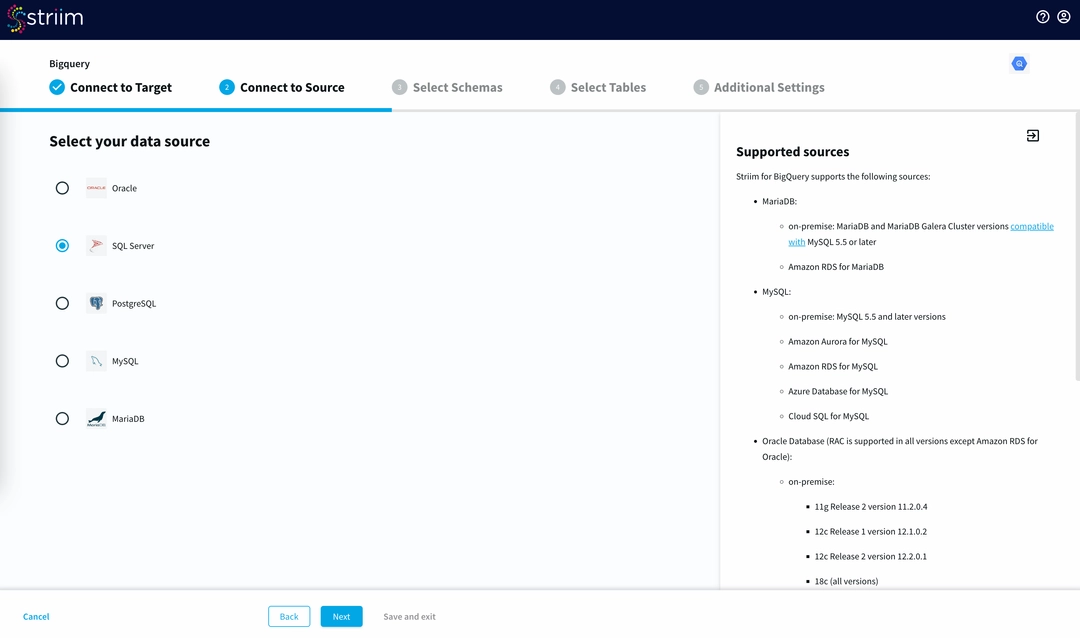
Striim supports various databases, including Oracle, SQL Server, PostgreSQL, MySQL, and MariaDB.
Additionally, Striim provides a powerful, intuitive platform for event stream processing, with out-of-the-box connectors.
Type: cloud
Ease of use: 3/5
Pricing: from $2500 per month
Free trial: 14 days
15. Oracle Data Integrator
Oracle Data Integrator is a powerful, high-performance tool used to move data from multiple sources, including flat files and databases, into a single destination. It is designed to help organizations improve their data integration processes and enable better business decision-making.
Oracle provides a graphical interface for designing and executing ETL jobs, as well as a range of features to help optimize data movement, including support for big data, data profiling, and a range of transformation functions.
Type: Enterprise
Ease of use: 4/5
Pricing: available on request
Free trial: none
16. Pentaho Data Integration
Pentaho Data Integration is an ETL tool used for data integration and data warehousing. It is a powerful, open-source resource that helps organizations manage and analyze data from disparate sources.
Pentaho provides a wide range of capabilities, including data extraction, transformation, and loading from heterogeneous data sources, data cleansing and transformation, and data quality assurance. It also features a graphical user interface for creating data pipelines and monitoring and managing the data flow.
Type: open-source
Ease of use: 4/5
Pricing: available on request
Free trial: none
17. Singer
Singer is a tool built for data engineers and data scientists. It is open source and written in Python, so it is easy to use and extend. Singer is designed to be used with a variety of data sources, including databases, web APIs, and flat files. It is flexible and extensible, allowing users to add additional functions to the ETL processes easily.
Type: open-source
Ease of use: 2/5
Pricing: free to use
18. AWS Glue Studio
AWS Glue automates the steps of extracting data from various sources, transforming it into a format that can be used for analysis, and loading it into target data stores.
With Glue, you can ingest data from various sources, including Amazon S3, Amazon RDS, and Amazon Redshift, as well as non-AWS sources.
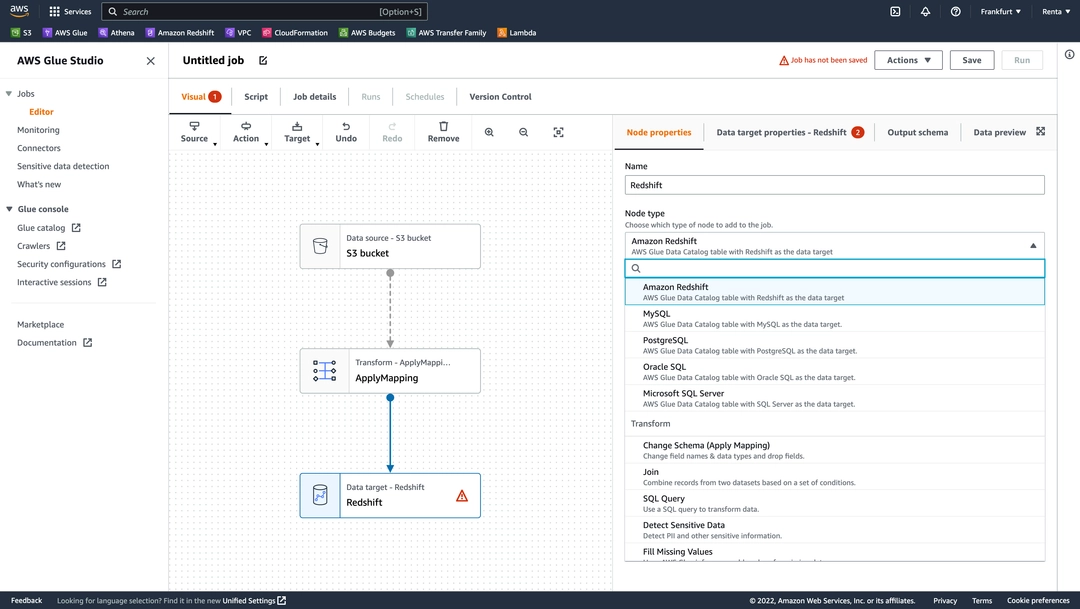
You can also create custom transformations and logic to manipulate and enrich the data. Glue provides a serverless environment, so you don’t need to worry about provisioning, scaling, and managing the infrastructure. In addition, it has an easy-to-use graphical interface and supports Python, Scala, and other popular programming languages for writing ETL jobs.
Type: cloud
Ease of use: 5/5
Pricing: from $0 per month
Free trial: none
The summary comparison of top ETL tools
Now that you’ve learned about each tool individually check out a side-to-side comparison to find the best option for you.
| Vendors | Type | Number of sources | Monthly price starts at |
|---|---|---|---|
| Renta ETL | ELT | 28 | 30$ |
| Integrate.io | ETL | 120 | n/d |
| Stitch | ELT | 130 | 100$ |
| Fivetran | ELT | 90 | 24$ |
| Hevo Data | ELT | 150 | 239$ |
| Supermetrics | ELT | 50 | 99$ |
| Skyvia | ETL | 140 | 15$ |
| Matillion | ETL | n/d | Pay-as-you-go |
| Dataddo | ELT | 200 | 99$ |
| Google Cloud DataFlow | ETL | n/d | Pay-as-you-go |
| Talend Open Studio | ETL | n/d | n/d |
| Informatica Power Center | ETL | n/d | 2000$ |
| Azure Data Factory | ETL | n/d | Pay-as-you-go |
| Striim | ETL | 100 | 2500$ |
| Oracle Data Integrator | ETL | n/d | n/d |
| Pentaho Data integration | ETL | n/d | open-source |
| Singer | ETL | 170 | open-source |
| AWS Glue | ETL | 11 | Pay-as-you-go |
ETL vs ELT: which data integration tool to choose?
ELT — extract, load, transform — is a newer version of the ETL process. The two terms are sometimes used interchangeably. However, switching two steps of the process significantly affects the way data exists and flows through business systems.
In ELT, raw data is directly loaded into the destination — only then it is transformed. This process allows coexisting of raw data and transformed data in one warehouse. This provides data professionals with the freedom to model the data after they explored and analyzed it in the raw format.
The ETL process does not provide professionals with such freedoms.
Key takeaways
There are plenty of high-quality ETL tools on the market, each with its own use case. As a result, some ETL tools can be used in tandem to create an environment in which data can be processed as efficiently as possible.
For instance, you can use Renta ETL to extract your data from numerous sources and upload it to your data lake based on AWS S3. Then, you can turn to AWS Glue to transform the data code-free, using a friendly graphic interface, and send it to the AWS Redshift warehouse. From there, you can distribute your transformed data to any business intelligence tool you want.
If you feel like Renta is the right solution for your company, take advantage of our free 7-day trial and explore all the features to build reliable data pipelines.
